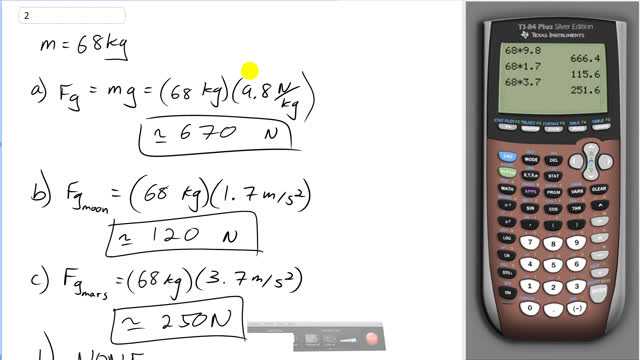
What is the weight of a 68-kg astronaut
- on Earth,
- on the Moon (),
- on Mars (),
- in outer space traveling with constant velocity?
- NONE

In order to watch this solution you need to have a subscription.
This is Giancoli Answers with Mr. Dychko. To find the weight of the astronaut in each location multiply the astronauts mass by the gravitational field strength or also known as the acceleration due to gravity. But it's better to think of it as gravitational field strength in this context I think. And you can write the m/s squared as Newtons per kilogram if you like, the unit's are equivalent. In this case makes a little bit more sense maybe to write Newtons per kilogram. So, multiply the 9.8 by 68 kilograms. Kilograms cancel leaving us with Newtons, and there's 670 Newtons would be the weight of the astronaut on Earth. On Moon the 68 kilograms gets multiplied by 1.7 Newtons per kilogram which makes 120 Newtons. And this is with two significant figures. On Mars multiply 68 kilograms by 3.7 m/s squared or Newtons per kilogram, whichever you'd like to call it. And that is 250 Newtons. And there would be no weight in outer space because there's no body to exert gravity, and it says they're traveling with constant velocity. So, there won't be any perceived weight due to the ship pushing on them either. So, d) is zero.
I'm hard of hearing, do you offer closed captioning?
Hi rlr1705, Thank you for this question. While it would be wonderful if I could offer closed captioning, it would be an enormous undertaking to do this for so many hours and hours of videos. I've thought about it, and gone as far as finding the best platform for making transcriptions (https://www.amara.org/en/), but even with being as efficient as possible I still unfortunately don't have the time for this. I can't even outsource the task since the videos are full of technical jargon that would be difficult for a non-physics specialist to transcribe, whereas a physics specialist would be too expensive. I presume your speech recognition software (Dragon Naturally Speaking?) can't handle the jargon either. I hope maybe the color coding of the algebra steps (substitutions are always in red), and the highlighted cursor can at least be somewhat helpful?
Hello. Can you explain D ) none. Why it is because there is no gravity out the space the there is vacum
Hi joeotilio25, part D) asks for the weight in outer space, so the two terms that need explaining are weight and outer space. weight means the force exerted by gravity (which is different from 'mass', by the way). outer space means being in a location very far away from anything else. Sure, as you say, you can think of outer space as being a vacuum. The important feature of outer space is that there is nothing there to exert any gravitational force on the astronaut. With no gravitational force, the astronaut will not have any weight.
Hope this helps,
Mr. Dychko